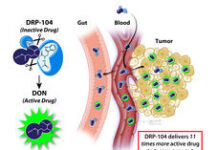Findings from a randomised phase II study show superiority of dabrafenib plus trametinib as first systemic treatment for paediatric patients with low-grade glioma with BRAF V600 mutations as compared with carboplatin plus vincristine, the standard chemotherapy approach. This benefit was evident in the higher independently determined response, longer progression-free survival (PFS), and better side-effect profile as reflected in the lower frequency of treatment discontinuation because of side effects.
Overall, the findings show the value of early molecular testing in children with low-grade glioma to determine the presence or absence of BRAF V600 mutations according to Dr. Eric Bouffet of the Hospital for Sick Children in Toronto, ON, Canada, and colleagues who published the results on 21 September 2023 in The New England Journal of Medicine.
Gliomas, a heterogeneous group of histologically distinct tumours, account for approximately 45% of all paediatric tumours of the central nervous system. The BRAF V600E mutation has been detected in 15-20% of paediatric low-grade gliomas, most frequently in pleomorphic xanthoastrocytoma, pilocytic astrocytoma, and ganglioglioma subtypes. Several retrospective analyses have shown that patients who have tumours with the BRAF V600E mutation may have a poorer response to chemotherapy, resulting in shorter PFS and overall survival, findings that confirm the need for improved treatment options in this molecularly selected population.
Dabrafenib monotherapy showed promising activity in a phase I/II study involving previously treated children with low-grade glioma with BRAF V600 mutations, results that supported paediatric evaluation of dabrafenib plus trametinib. A previous phase I/II study evaluated the side-effect profile and preliminary clinical activity of dabrafenib plus trametinib in pretreated paediatric patients with low-grade glioma with BRAF V600 mutations. In the latest article, the authors report the subsequent results of a phase II, randomised, open-label study that evaluated the efficacy and safety of dabrafenib plus trametinib as compared with standard of care, carboplatin plus vincristine, as first-line treatment in this molecularly selected population.
In this phase II study, patients with paediatric low-grade glioma with BRAF V600 mutations who were scheduled to receive first-line treatment were randomly assigned in a 2:1 ratio to receive dabrafenib plus trametinib or standard chemotherapy, carboplatin plus vincristine. The primary outcome was the independently assessed overall response (complete or partial response) according to the Response Assessment in Neuro-Oncology criteria. Also assessed were the clinical benefit (complete or partial response or stable disease for ≥24 weeks) and PFS.
A total of 110 patients underwent randomisation, 73 to receive a combination of oral dabrafenib divided into two equal doses per day (< 12 years of age, 5.25 mg per kilogram of body weight per day; ≥ 12 years of age, 4.5 mg per kilogram per day) plus trametinib once daily (< 6 years of age, 0.032 mg per kilogram; ≥ 6 years, 0.025 mg per kilogram) and 37 to receive standard chemotherapy, carboplatin plus vincristine, according to the doses and schedule used in the Children’s Oncology Group A9952 study. Liquid formulations of dabrafenib and trametinib were available.
At a median follow-up of 18.9 months, an overall response occurred in 47% of the patients treated with dabrafenib plus trametinib and in 11% of those treated with chemotherapy (risk ratio 4.31; 95% confidence interval [CI] 1.7 to 11.2; p < 0.001). Clinical benefit was observed in 86% of the patients receiving dabrafenib plus trametinib and in 46% receiving chemotherapy (risk ratio 1.88; 95% CI 1.3 to 2.7). The median PFS was significantly longer with dabrafenib plus trametinib than with chemotherapy (20.1 months versus 7.4 months, hazard ratio 0.31, 95% CI 0.17 to 0.55; p < 0.001).
The safety profile of dabrafenib plus trametinib was consistent with that observed in adults across other indications, with pyrexia and fatigue among the most common adverse events. However, weight gain as an adverse event or an increase of at least 2 body mass indices for age percentiles was reported in 32 of 73 patients who received dabrafenib plus trametinib. Fewer patients in the group receiving dabrafenib plus trametinib than in the chemotherapy group had adverse events of grade 3 or higher (47% versus 94%) and fewer discontinued therapy because of adverse events (4% versus 18%).
According to the authors, potential side effects with dabrafenib plus trametinib and the risk–benefit ratio should be evaluated on an individual basis, particularly because indefinite treatment may be required and the long-term safety of dabrafenib plus trametinib in this population is unknown. A rollover study to assess the long-term effects of therapy with dabrafenib, trametinib, or a combination of both drugs in paediatric patients is ongoing. Future studies are needed to evaluate functional outcomes (e.g. visual acuity), further molecular characterisation, and most effective treatment duration.
The study was supported by Novartis.
Reference
Bouffet E, Hansford JR, Garrè ML, et al. Dabrafenib plus Trametinib in Pediatric Glioma with BRAF V600 Mutations. N Engl J Med 2023;389:1108-1120.








